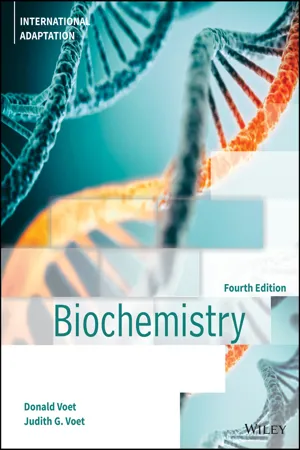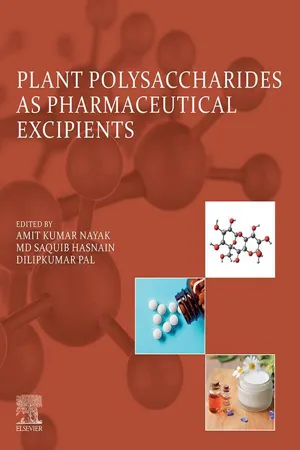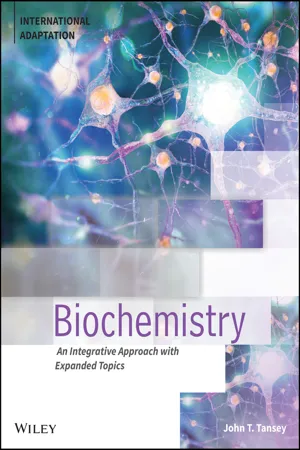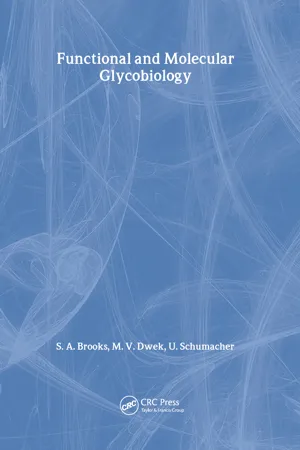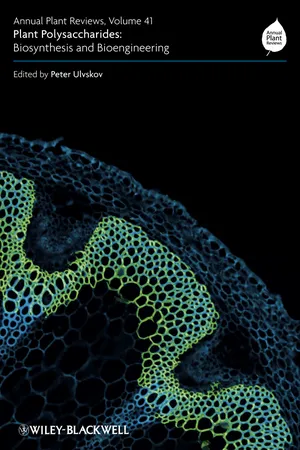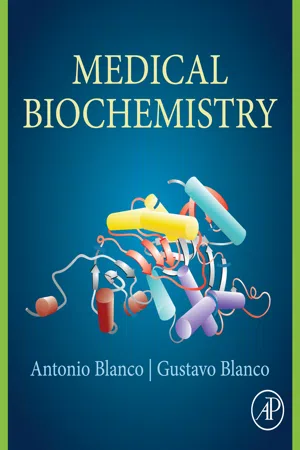Biological Sciences
Polysaccharides
Polysaccharides are complex carbohydrates made up of multiple sugar units linked together. They serve as energy storage molecules in organisms and play structural roles in cell walls and extracellular matrices. Examples of polysaccharides include starch, glycogen, and cellulose, each with distinct functions and properties in biological systems.
Written by Perlego with AI-assistance
Related key terms
10 Key excerpts on "Polysaccharides"
- eBook - ePub
- Donald Voet, Judith G. Voet(Authors)
- 2021(Publication Date)
- Wiley(Publisher)
10 Sugars and Polysaccharides1 MonosaccharidesA. ClassificationB. Configurations and ConformationsC. Sugar Derivatives2 PolysaccharidesA. Carbohydrate AnalysisB. DisaccharidesC. Structural Polysaccharides: Cellulose and ChitinD. Storage Polysaccharides: Starch and GlycogenE. Glycosaminoglycans3 GlycoproteinsA. ProteoglycansB. Bacterial Cell WallsC. Glycoprotein Structure and FunctionD. GlycomicsCarbohydrates or saccharides (Greek: sakcharon, sugar) are essential components of all living organisms and are, in fact, the most abundant class of biological molecules. The name carbohydrate, which literally means “carbon hydrate,” stems from their chemical composition, which is roughly (C ⋅ H2 O)n, where n ≥ 3. The basic units of carbohydrates are known as monosaccharides. Many of these compounds are synthesized from simpler substances in a process named gluconeogenesis (Section 15-7 ). Others (and ultimately nearly all biological molecules) are the products of photosynthesis (Section 21-3 ), the light-powered combination of CO2 and H2 O through which plants and certain bacteria form “carbon hydrates.” The metabolic breakdown of monosaccharides (Chapters 15 and 19) provides much of the energy used to power biological processes. Monosaccharides are also principal components of nucleic acids (Section 4-1A ), as well as important elements of complex lipids (Section 11-1D ).Oligosaccharides consist of a few covalently linked monosaccharide units. They are often associated with proteins (glycoproteins) and lipids (glycolipids) in which they have both structural and regulatory functions (glycoproteins and glycolipids are collectively called glycoconjugates). Polysaccharides consist of many covalently linked monosaccharide units and have molecular masses ranging well into the millions of daltons. They have indispensable structural functions in all types of organisms but are most conspicuous in plants because cellulose, their principal structural material, comprises up to 80% of their dry weight. Polysaccharides such as starch in plants and glycogen - eBook - ePub
Pullulan
Processing, Properties, and Applications
- Shakeel Ahmed, Aisverya Soundararajan, Shakeel Ahmed, Aisverya Soundararajan(Authors)
- 2020(Publication Date)
- Jenny Stanford Publishing(Publisher)
Chapter 1Polysaccharides: An OverviewS. Vijayanand,a Ashwini Ravi,a Aisverya Soundararajan,b Annu,c P. N. Sudha,b and J. Hemapriyada Bioresource Technology Lab, Department of Biotechnology, Thiruvalluvar University, Serkkadu, Vellore 632115, Tamil Nadu, Indiab Biomaterial Research Lab, Department of Chemistry DKM College for Women (Autonomous), Vellore 632001, Tamil Nadu, Indiac Department of Chemistry, Jamia Millia Islamia, New Delhi 110025, Indiad PG & Research Department of Microbiology, DKM College for Women (Autonomous), Vellore 632001, Tamil Nadu, India[email protected]Polysaccharides, commonly known as “Cinderella of biopolymers,” are molecules composed of monosaccharide residues, which are joined together by O-glycosidic linkages. Naturally, Polysaccharides are produced by various biological entities such as plants, microbes, seaweeds, and animals. Polysaccharides were often found to have linear structure, and it may also contain various degrees of branching. Despite their structure, they also vary in various components such as monosaccharide composition, linkage type, pattern of linkage, chain type, degree of polymerization, etc. based on the source of production. This variable structure of Polysaccharides is responsible for their physiochemical and biological characteristics, which in turn is responsible for their diversified applications. They are used in various industries such as pharmaceutical industry, food industry, and other non-food industries. With further advancements in technologies, Polysaccharides have been structurally modified and studied for their various functions. In addition to these, the formation of nanocomposite with these polymers has been studied extensively for various applications from biosensors to drug delivery They also find their importance in environmental applications by taking up several xenobiotics. Therefore, in this chapter, various Polysaccharides from nature have been discussed in detail along with their applications. - Amit Kumar Nayak, Md Saquib Hasnain, Dilipkumar Pal(Authors)
- 2022(Publication Date)
- Elsevier(Publisher)
4] . They are abundant materials on Earth and can be found in plants and living organisms. Polysaccharides are valuable biological biopolymers. They play essential functions in living organisms, including in structure and storage-related roles. Microorganisms secrete Polysaccharides to enable adhesion to surfaces and prevent drying.Several Polysaccharides were reported, including cellulose, celluloid (nitrocellulose and camphor), cellulose acetate, nitrocellulose, callose, mannan, xylan, inulin, arabinoxylan, fucoidan, galactomannan, xanthan gum, dextran, welan gum, gellan gum, diutan gum, and pullulan. Polysaccharides have been applied for several applications, including skincare [5] , water treatment [6 –8] , gene delivery [9] , wound healing [10] , and surgical threads. The presence of functional groups such as sulfonated Polysaccharides offered high performance for biomedical applications [11] .Polysaccharides offer potential performance for biomedical implants. This book chapter summarizes the applications of Polysaccharides for biomedical implants. It introduces the properties and structure of some Polysaccharides that can be used for biomedical implants. A brief introduction to Polysaccharides is also included showing the structure, classification, and properties of Polysaccharides. We discuss the biomedical applications of Polysaccharides for tablet formulation, coating biomedical implants, dental implants, tumor-targeting implant and regenerative medicine, bone and tissues engineering, drug delivery, and three-dimensional (3D) printing for bacterial Polysaccharides.24.2 Polysaccharides’ properties and structure
The general component of natural Polysaccharides is simple carbohydrates called monosaccharides with the chemical formula of (CH2 O)n ; where n >3. The common monosaccharides are glucose, fructose, and glyceraldehyde with the chemical formula of (CH2 O)6 or C6 H12 O6 . Thus the general formula of Polysaccharides can be described as Cx (H2 O)y , where x =200–2500. If the repeating units in the polysaccharide backbone are six-carbon monosaccharides such as glucose, the general chemical formula can be described as (C6 H10 O5 )n , where 40≤n ≤3000. If n- eBook - ePub
Biochemistry
An Integrative Approach with Expanded Topics
- John T. Tansey(Author)
- 2022(Publication Date)
- Wiley(Publisher)
CHAPTER 8 Carbohydrates II Polysaccharides in Context Carbohydrates are nearly as diverse as proteins, and what they lack in functional group diversity and catalytic power, they make up for in overall diversity of form and structure. Starch and cellulose are Polysaccharides, but so is glycogen, which acts as a store of energy in animals. Substances as diverse as mucus and connective tissue are largely comprised of Polysaccharides, or proteins decorated with lengthy carbohydrate chains. These molecules are key to growth, development, and immunity; they also impart structure to the organism as a major component of cartilage and connective tissue. The many roles that carbohydrates play in biochemistry are just beginning to be understood. This chapter starts with a discussion of the metabolism of glycogen. It highlights the regulation of glycogen metabolism, particularly how it differs from tissue to tissue, and its response to different chemical stimuli (hormones). Section 8.2 looks at the pentose phosphate pathway, which generates NADPH for lipid biosynthesis and redox needs of the cell, generates ribose-5-phosphate for nucleotide biosynthesis, and provides a way to catabolize other carbohydrates in the cell. Sections 8.3 and 8.4 discuss the properties and chemistry of the extracellular matrix: Section 8.3 focuses on Polysaccharides in glycoproteins, glycolipids, proteoglycans, and peptidoglycans, and section 8.4 discusses matrix proteins and their assembly - eBook - ePub
- Dr Susan Brooks, Dr M Dwek, Udo Schumacher(Authors)
- 2023(Publication Date)
- Garland Science(Publisher)
3 Polysaccharides3.1 Introduction – how are Polysaccharides defined?
Polysaccharides are polymers of monosaccharide units linked by glycosidic bonds into linear or branching chains. Branching is possible because of the diversity in glycosidic bonds that can be formed to link any of the hydroxyl groups of the component monosaccharides (Chapter 1 ). The two main patterns of branching form either comb- or tree-like structures (Figure 3.1 ). There is no rigorously defined division between oligosaccharides and Polysaccharides (see 1.16.3 ), but Polysaccharides are usually accepted to contain more than 10–20 monosaccharide residues, and in practice are usually much larger than this, typically comprising ≈ 100 monosaccharide units or more, with cellulose comprising ≈ 3000 monosaccharide units. Connective tissue Polysaccharides which contain one or more amino sugar moieties are usually referred to as glycosaminoglycans, and are considered separately in Chapter 8 - Shilin Chen, Andrew Marston, Hermann Stuppner, Shilin Chen, Andrew Marston, Hermann Stuppner(Authors)
- 2014(Publication Date)
- Wiley(Publisher)
18 Analysis of Plant Oligo- and PolysaccharidesWolfgang BlaschekDepartment of Pharmaceutical Biology, University of Kiel, Kiel, Germany1 Introduction
Carbohydrates represent the major organic substance on earth. They are mainly built in the process of photosynthesis by cyanobacteria and aquatic and land plants. Carbohydrates are structural elements of nucleic acids (DNA and RNA), some coenzymes (e.g., NAD(P)H and ATP), glycoproteins, and many secondary products (e.g., flavonoid glycosides, anthraquinone glycosides, and cardiac glycosides). Most plants use carbohydrates, especially the disaccharide sucrose to transport energy (in the phloem). Carbohydrates can bear information in molecular or cellular recognition. The bulk of carbohydrates in plants, however, are storage Polysaccharides (e.g., starch and fructans) or cell wall Polysaccharides (e.g., pectins, hemicelluloses, and cellulose) (Nishinari et al., 2007; Fry, 2011).Monosaccharides are the basic structural unit of oligo- and Polysaccharides. The most common monosaccharides occurring in oligo- and Polysaccharides are arabinose and xylose (pentoses); glucose, galactose, mannose, and fructose (hexoses); rhamnose and fucose (6-deoxy hexoses); and galacturonic acid and glucuronic acid (hexuronic acids).Disaccharides are carbohydrates in which two monosaccharide units are joined by a glycosidic linkage.Oligosaccharides by definition contain up to 10 monosaccharide residues joined by glycosidic linkages. According to the number of monosaccharide residues, they are trisaccharides, tetrasaccharides, pentasaccharides, and so on and then have a degree of polymerization (DP) of 3, 4, 5, and so on, respectively. Oligosaccharides may be linear, branched, or even cyclic (cyclodextrins). For oligosaccharides, a defined structure can be given.Some examples for common plant di- and oligosaccharides are given in Table 1 .Table 1- eBook - ePub
Biochemistry Explained
A Practical Guide to Learning Biochemistry
- Thomas Millar(Author)
- 2018(Publication Date)
- CRC Press(Publisher)
6 Complex Sugars and their Functions In this chapter you will:- learn about homopoly saccharides and hetero-Polysaccharides
- study in detail the structure and functions of the Polysaccharides – cellulose, chitin, starch and glycogen
- study the structure of common glycosaminoglycans (GAGs): hyaluronate, chondroitin sulphate, dermatin sulphate, heparan sulphate, keratan sulphate
- learn about the acid substituted sugars, particularly glucuronic and iduronic acids, and sulphated sugars.
- learn about the structure of bacterial cell walls
- investigate the nature and functions of proteoglycans, oligosaccharides and glycoproteins: laminin, fibronectin, integrin
- study the functions of plant, animal and bacterial lectins
- study the role of sugars in the formation of cerebrocides
- learn the importance of sugar residues for determining blood groups
HomoPolysaccharides
Nomenclature : HomoPolysaccharides are sugar polymers made from one particular sugar unit. HeteroPolysaccharides are polymers made from different sugar units. In both cases these may be linear or branched polymers.Celluloses
Celluloses are the major components of plants comprising 20%-45% of their cell wall mass, and as such, the most abundant organic compound on Earth. It enables trees to attain their great heights and yet it is, unbelievably, just a polymer of glucose. Its basic unit is a chain of glucose linked by β(1→4) glycosidic bonds (cellobiose). These chains are in parallel alignment and held in place by hydrogen bonding between the chains. Major variations are in the degree of polymerisation which appears to be biphasic: either being less than 500 glucose units or between 2500 and 4500 glucose units per chain. - eBook - ePub
Annual Plant Reviews, Plant Polysaccharides
Biosynthesis and Bioengineering
- Peter Ulvskov, Peter Ulvskov(Authors)
- 2010(Publication Date)
- Wiley-Blackwell(Publisher)
Chapter 14 PLANT CELL WALL BIOLOGY: Polysaccharides IN ARCHITECTURAL AND DEVELOPMENTAL CONTEXTS14.1 IntroductionMaureen C. McCann1 and J. Paul Knox21 Biological Sciences, Purdue University, West Lafayette, IN 47907, USA2 Centre for Plant Sciences, Biological Sciences, University of Leeds, Leeds LS2 9JT, UKAbstract:Land plant cell walls contain in the region of 11 major Polysaccharides that are grouped as cellulose, hemicelluloses and pectins. Methodologies involving the use of molecular probes and advanced spectroscopies are revealing considerable diversity and complexity as to how these Polysaccharides are configured within cell wall structures. Our knowledge of the integration of selected sets of Polysaccharides into diverse and multifunctional primary and secondary cell walls is currently increasing although many challenges remain. In addition to understanding the structure and function of Polysaccharides in the architectures of individual cell walls and in varied developmental contexts there is also a taxonomic dimension to cell wall Polysaccharides that is likely to reveal insights into functions. Challenges for future studies include the understanding of aspects of possible polysaccharide redundancy during cell wall assembly and function, and of how specific Polysaccharides are integrated with the mechanical attributes of cell walls and the placing of specific polysaccharide dynamics within physiological frameworks of regulation.Keywords: architecture; carbohydrate-binding modules; cell wall biology; microstructure; monoclonal antibodies; plant cell adhesion; spectroscopy.Cell walls are central to many cell processes that are fundamental to plant growth and survival. Cell walls are also significant materials in the contexts of food, paper, polymers, textiles and fuel. Many of the sets of plant Polysaccharides discussed elsewhere in this book are quantitatively the most important macromolecular components of cell walls. Our understanding of how these sets of Polysaccharides are assembled to provide functionally diverse, mechanically flexible but robust sets of cell walls is the basis of this chapter. Cell wall Polysaccharides are currently separated into cellulose, hemicelluloses and pectic polymers – groupings largely derived from both structural features and solubilization properties. The latter two groups contain polysaccharides of considerable structural diversity and complexity and, in addition, contain polymers that are subject to structural modulation within cell walls. - eBook - ePub
- Raymond S. Ochs(Author)
- 2021(Publication Date)
- CRC Press(Publisher)
4 CarbohydratesCarbohydrates are most commonly encountered as the sweetener sucrose and as starch, the nutrient of bread and pasta. The carbohydrates are literally hydrates of carbon, having the empirical formula (CH2 O)n . Because they possess both hydroxyl and carbonyl groups, they are a step up in complexity from lipids. Unlike lipids, carbohydrates are generally very soluble in water. The Latin word for sugar is saccharide; this is commonly used in the term Polysaccharides. Sugars are nutrients for both animals and plants. Animals use sugars for rapid (i.e., minute-to-minute) energy production and lipids for long-term storage. Plants use sugars for energy exclusively, except at the seed stage. Sugars have greater weight than lipids, making them less suitable for long-term energy storage for organisms with mobile lifestyles (i.e., animals and seeds). The reason for the greater mass of sugars is two-fold. Sugars contain more oxygen atoms and are thus denser than lipids. Sugars also associate with water (through hydrogen bonding), further increasing their weight.Aside from providing energy, sugars have a wide variety of roles once they are chemically modified, such as cell–cell recognition and signaling. The specificity of blood group types derives from sugars attached to membrane lipids of red blood cells. Proteins secreted from cells are usually covalently linked to sugars. Thus, sugars are integral to biological function. We begin our study of sugars with the simplest ones: the monosaccharides.4.1 Monosaccharides
Monosaccharides have a single carbonyl group, which occurs at the first or second carbon atom. All remaining carbons have an attached hydroxyl group. There are two classes of monosaccharides: aldoses and ketoses. Aldoses (aldehydes) have the carbonyl at carbon one, whereas ketoses (ketones) have the carbonyl at carbon two.The “-ose” suffix (as in aldose and ketose) usually indicates that a compound is a sugar. The general category name for sugars is shown in Table 4.1 , starting with the smallest, the triose - eBook - ePub
- Antonio Blanco, Gustavo Blanco(Authors)
- 2017(Publication Date)
- Academic Press(Publisher)
A glycoprotein of the ovule, zona pellucida (ZP3) contains oligosaccharides recognized by receptors on the surface of sperm. This allows the interaction of female and male gametes prior to fertilization.The adhesion of bacteria, viruses, and toxins to the cell surface requires the presence of specific carbohydrates in glycoproteins and glycolipids of cell membranes. For example, Escherichia coli and Salmonella typhimurium bind to mannose residues on the cell plasma membrane. An observation of interest related to this phenomenon is the loss of invasive ability of bacteria, viruses, or toxins when they are previously incubated with the carbohydrate that they selectively recognize. The added carbohydrate blocks the receptor site in the microorganism or toxin and renders it harmless.Changes in surface oligosaccharides have been observed in malignant tumor cells. Some authors propose that such changes are the determinants of the anomalous behavior of neoplastic cells. The alteration of the signals that determine the “social relations” among cells contribute to the uncontrolled cell growth and multiplication.These examples give an idea of the importance of these molecules. Advances in this field have opened new perspectives for the interpretation of many biological phenomena and provide opportunities for application in clinical practice.Summary
Carbohydrates are polyhydroxyaldehydes , polyhydroxyketones , and polymers , which, upon hydrolysis, can generate those compounds. They are classified into:1. monosaccharides, or simple sugars;2. oligosaccharides consisting of 2–10 monosaccharides;3. Polysaccharides, formed by a large number of monosaccharides.Monosaccharides (MS) include aldoses or ketoses , which contain an aldehyde or ketone function, respectively. According to the number of carbon atoms in the molecule they can be trioses, tetroses, pentoses, etc. All have reducing capacity when placed in alkaline medium.Optical isomerism is a property of MS; the simplest aldotriose, glyceraldehyde, has an asymmetric or chiral C, which makes it optically active. The dextrorotatory isomer is designated D and the levorotatory L . The capacity of a MS to produce isomers increases with the number of asymmetric C in the MS molecule. The number of possible optical isomers for any given MS is calculated by the formula 2n , where n is the number of chiral C. All MS in which the configuration of the C containing the secondary alcohol (which is located farther away from the aldehyde or ketone function) is the same as that of the C2 of D -glyceraldehyde, belong to the D series, regardless of the sign of its optical activity. The human body synthesizes, almost exclusively, D
Learn about this page
Index pages curate the most relevant extracts from our library of academic textbooks. They’ve been created using an in-house natural language model (NLM), each adding context and meaning to key research topics.
